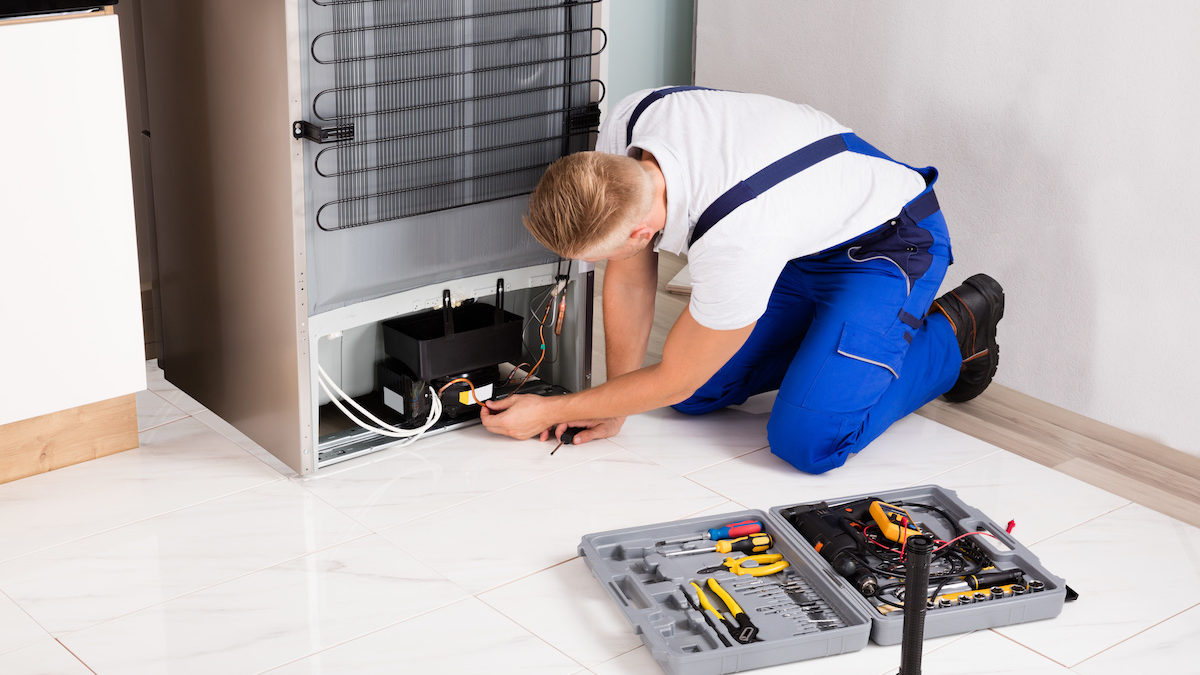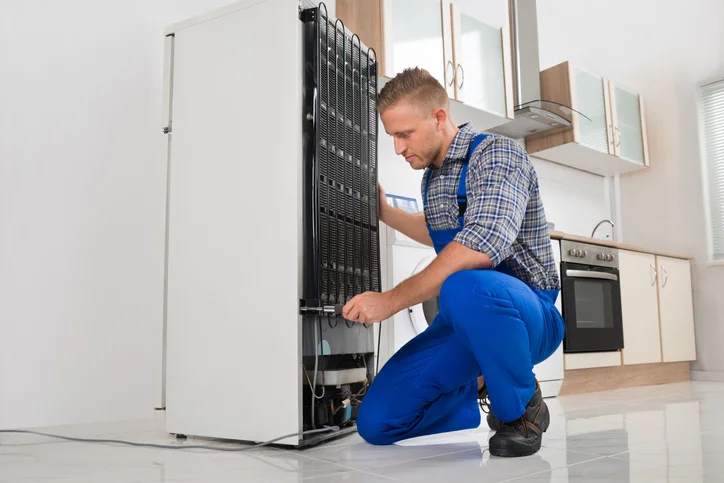Dependable Refrigeration & Appliance Repair Service LG Appliance Repair Checklist: How to Detect Common LG Appliance Problems Early
Dependable Refrigeration & Appliance Repair Service LG Appliance Repair Checklist: How to Detect Common LG Appliance Problems Early
Blog Article
Necessary Tips for Effective Ref Repair to Prolong Device Lifespan
When it comes to your fridge, proper repair and maintenance are important for long life. Understanding common problems and knowing when to act can make all the difference.
Comprehending Usual Fridge Troubles
Refrigerators are essential in maintaining your food fresh, however they can run into an array of typical troubles that disrupt their performance. If you notice food ruining quicker than common, examine the thermostat setups or consider if the door seals are harmed. Acknowledging these issues early can save you time and money in repair services, ensuring your fridge runs efficiently and successfully.
Regular Upkeep Practices
To keep your appliances running efficiently, you need to remain on top of normal upkeep practices. Tidy the condenser coils, examine the door seals, and monitor the temperature settings to ensure peak performance. These basic tasks can conserve you money and time on fixings down the line.
Clean Condenser Coils On A Regular Basis
Cleaning your condenser coils routinely can significantly boost your appliance's performance. Dirt and dirt construct up on these coils over time, causing your appliance to function tougher and take in even more energy. To maintain them clean, disconnect your appliance and thoroughly get rid of any kind of safety covers.
Check Door Seals
Three basic steps can aid you ensure your appliance's door seals remain in excellent condition. Evaluate the seals on a regular basis for any kind of cracks, splits, or indicators of wear. These problems can cause air leakages, influencing efficiency. Second, clean the seals making use of warm, soapy water to remove any particles or grime. A clean seal assures a tight fit and better performance. Carry out an easy test by closing the door on a piece of paper. If you can conveniently pull it out without resistance, the seal may require changing. By complying with these actions, you'll preserve your device's performance and long life, conserving you money on energy expenses and repair services over time.
Display Temperature Level Setups
Routinely monitoring your device's temperature level settings is crucial for finest efficiency and effectiveness. Whether you're dealing with a refrigerator, fridge freezer, or stove, maintaining an eye on these settings can prevent lots of issues. For fridges, go for temperature levels between 35 ° F and 38 ° F; for freezers, remain 0 ° F. If the temperature levels are expensive or reduced, your home appliance might function harder, squandering energy and shortening its life-span. Make use of a thermometer to check these setups regularly, especially after major changes, like relocating your home appliance or readjusting the thermostat. If you observe variations, change the setups as necessary and seek advice from the user manual for assistance. By staying proactive about temperature level monitoring, you'll assure your appliances run smoothly and last longer.
Troubleshooting Cooling Problems
When your refrigerator isn't cooling down correctly, it can result in ruined food and threw away cash, so resolving the concern immediately is important. Begin by inspecting the temperature settings to confirm they go to the recommended levels, normally around 37 ° F for the refrigerator and 0 ° F for the fridge freezer. If the setups are appropriate, check the door seals for any gaps or damage; a faulty seal can permit cozy air to get in.
Next, analyze the vents inside the fridge and freezer. Validate they're not blocked by food things, as this can interfere with air movement. Pay attention for the compressor; if it's not running or making unusual noises, it might require focus. Check the condenser coils, typically situated at the back or bottom of the device. Dust and debris can accumulate, triggering cooling concerns. Tidy them with a vacuum cleaner or brush to optimize efficiency. If issues persist, it may be time to call an expert.
Repairing Water Leak and Ice Build-Up
If you're handling water leakage or ice accumulation in your home appliance, it's important to recognize the source of the trouble. By pinpointing where the water is coming from, you can stop further concerns and avoid costly repair work. Allow's check out some efficient methods to tackle these usual problems.
Determine Leakage Resources
How can you properly recognize the resources of water leakage and ice accumulation in your appliances? Beginning by checking the seals and gaskets on link your refrigerator and freezer doors. A used or damaged seal can enable cozy air to enter, triggering condensation and ice. Next, check the drain frying pan and water drainage system for clogs or blockages; a backed-up drainpipe can cause water pooling. Look for any kind of loose links in the water line, which can create leakages. Take a look at the defrost drain for ice buildup, which might interfere with correct drain. By systematically inspecting these locations, you'll pinpoint the resource of the trouble, permitting you to take the required steps to fix it and extend your home appliance's life-span.
Prevent Ice Formation
To prevent ice formation in your appliances, beginning by validating the temperature level settings are suitable. If your refrigerator or fridge freezer is as well chilly, it can bring about extreme ice accumulation. Inspect the door seals routinely; damaged seals can allow cozy air in, creating condensation and ice development.
Keep the home appliance well-ventilated and avoid overcrowding, as this can block air flow - GE appliance repair Oro Valley Dependable Refrigeration & Appliance Repair Service. Routinely defrost your freezer if it doesn't have an automated defrost function.
If you discover water leak, identify and deal with any type of blocked drain holes, as they can add to ice build-up. Tidy the coils and confirm they're functioning appropriately to preserve peak performance. Taking these actions will assist prolong your appliance's life-span and effectiveness.
Attending To Noisy Refrigerator Appears
While it might seem alarming, a loud refrigerator often signifies small issues rather than significant breakdowns. Common perpetrators include the compressor, fans, and water lines.
Next, look for loose items inside. Often, containers or racks can rattle, producing unwanted sound. Tighten or rearrange them to remove the audios.
If you observe a clicking noise, it may be the defrost timer. This is commonly safe but might indicate it requires evaluation.
Ultimately, validate your refrigerator is degree. An out of balance appliance can generate vibrations and sound. Make use of a degree to examine, and readjust the feet if required. Attending to these problems quickly can assist preserve your fridge's efficiency and extend its life-span.
When to Change Parts vs. Complete Replacement

Nevertheless, if your device is older and experiencing multiple concerns, a complete replacement might be extra economical. Take into consideration the expense of fixings versus the appliance's worth. If fixings exceed 50% of a new device's price, it's typically better to spend in a replacement. Furthermore, if you see ongoing issues that maintain recurring, it's a sign that your device has actually reached the end of its life. Evaluate these aspects meticulously to make the very best decision for your requirements and spending plan.
Recognizing When to Call an Expert
Exactly how can you inform when it's time to call in a professional for appliance repair? If your appliance quits functioning entirely or often journeys circuit breakers, it's one more red flag.
You must additionally consider your very own convenience level with repair work. If you're unsure regarding diagnosing the trouble or do not have the right devices, it's best to connect for assistance. Keep in mind, trying complex repair services can bring about even more damage or also safety threats.

Often Asked Questions
How Commonly Should I Clean the Fridge Coils?
You need to clean your fridge coils every 6 months. This helps keep performance and stops overheating. If you observe too much dirt or animal hair, tidy them more frequently to guarantee your fridge runs efficiently.

Can I Utilize Vinegar for Cleaning My Refrigerator?
Yes, you can make use of vinegar to clean your refrigerator! It's an exceptional all-natural cleanser that gets rid of odors and discolorations. Dependable Refrigeration & Appliance Repair Service LG Appliance Repair. Simply blend it with water, apply it to surfaces, and wipe down for a fresh, clean refrigerator
What Temperature Should My Refrigerator Be Ready To?
You should set your refrigerator to 37 ° F(3 ° C) for suitable food conservation. This temperature maintains your food fresh while preventing perishing, guaranteeing your grocery stores last longer and minimizing waste. It's an easy adjustment you can make!
Does a Fridge Need to Be Leveled?
Yes, your fridge requires to be leveled. If it's irregular, it can affect cooling performance and trigger excess noise. Check the progressing legs and readjust them to guarantee appropriate equilibrium for optimal efficiency.
Just How Can I Lower Refrigerator Energy Consumption?
To decrease your refrigerator's energy usage, keep it tidy and well-ventilated, inspect door seals for leakages, set the temperature level in between 35-38 ° F, and hop over to these guys prevent straining it. These steps can substantially lower your energy bills.
Report this page